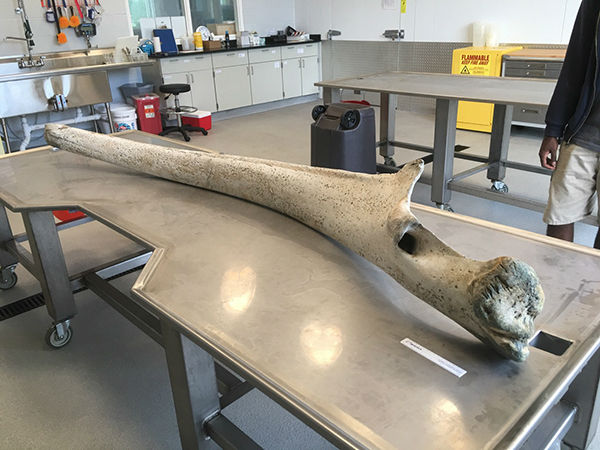This summer brought some unusual stranding events to the Alabama Marine Mammal Stranding Network (ALMMSN), housed here at the Dauphin Island Sea Lab.
The ALMMSN team typically responds to bottlenose dolphin and West Indian manatee strandings in local waters, but this summer, not one, but two large whale bones were discovered and brought to the Marine Mammal Research Center on the DISL campus.
The first bone, discovered by fishermen trawling 65 miles south of Mobile Bay and measuring more than 6 feet long, was identified as the upper jaw bone of a great sperm whale (Physter microcephalus). Great sperm whales, which can grow up to 70 feet long, are an endangered species in the U.S. and a species of special concern in the Gulf of Mexico.

When a second large whale bone was reported to ALMMSN in September, it was originally thought to be a rib bone, measuring almost 9 feet long. After consulting with large whale experts at the University of North Carolina in Wilmington, it was identified as another jaw bone. Again, discovered and reported by local fishermen trawling offshore, this second jaw bone belonged to a Bryde’s whale (pronounced “Brew-days”; Balaenoptera brydei), the only known baleen whale in the Gulf of Mexico.
While it may seem odd to classify a whale bone as a “stranding,” marine mammal strandings include live animals in distress, dead animals and dead animal remains such as bones. Every marine mammal, whether a live animal or a single bone, is covered under the jurisdiction of the Marine Mammal Protection Act, and for researchers even very old bones or decomposed carcasses can provide valuable information about the 30 marine mammal species found in the Gulf of Mexico.
You can report live or dead stranded marine mammals 24-7 to ALMMSN at 1-877-WHALE-HELP and help continue their valuable research on these unique animals that are part of our heritage here on the northern Gulf of Mexico coast.